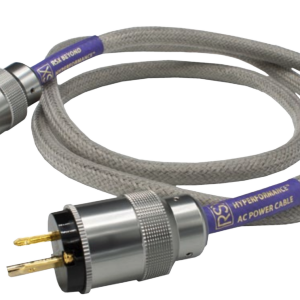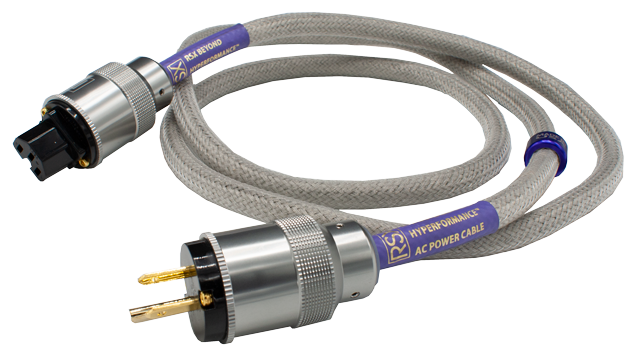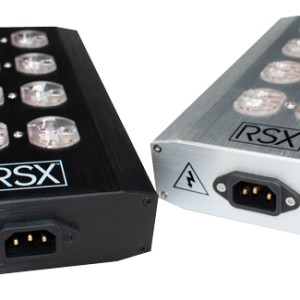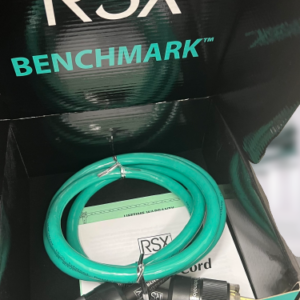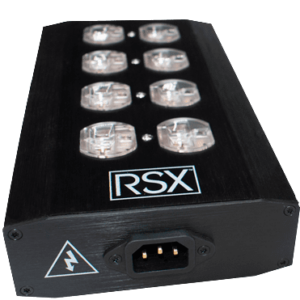Description
New company, new product alert!
Roger Skoff is back in the game, with a new company and new products.
At 9AWG, the spellbinding Beyond Power Cord is the top of the RSX Technologies range, designed by the renowned Roger Skoff of XLO fame. Pricey, but a strong performer, it fits quite nicely in the audiophile world of those looking for a game-changer for their high-resolution system. I am a connoisseur of power cords, so to speak, and find them essential to fine-tuning a reference system to peak performance. I agree with the old adage that it’s the last 6 feet of cable ahead of a component that is most sonically important.
My suggestion is one should have a strong selection of excellent power cords handy to max out your key components. In my system I pick the best power cord last to bring out the very best tonality and realism. I substituted the new Beyond in numerous positions and heard excellent results. It joins my references from Cardas, Kubala-Sosna, Kimber, Jorma, Dynamic Design, and the high-value UITaudio for tweaking the best components.
The overall and most consistent nature of Beyond is an improved dynamic range. It extends the high band, enhancing sparkle and air. The mid-band is a bit more powerful and beautifully
natural. The low band has a strong powerful character adding excitement and energy—not so much as to overdo things, but enough to let you know what might be missing. Rather, on a power-hungry amplifier or subtle DAC, the Beyond brought its special nature to every piece I tried.
With my EAR 890 Amplifiers, I heard a lovely dynamic boost top to bottom with particular added excitement and control in the mid and low bass range. The hefty copper composition seems to let more current into the amplifier, while the double insulation enhances the black background. The overall definition is very complimentary to this tube design and should be a superb choice for any power-hungry designs. I am impressed.
The Beyond is terrific with front-end gear. With a low-power DAC or phono stage, the ultra-low quiet and lack of any mechanical nature seems to compliment precision components and bring out their best nature. After much experimenting, I found the more reticent gear enjoyed the presence of the Beyond more than components already emphasizing attack and high dynamic range – though you will never know what you are missing until you try the Beyond and hear what happens.
I must compliment RSX for building a handsome elegant cable that is flexible, too. With magnificent fit and finish and large beefy connectors, it is a looker of a power cord.
I have quite a collection of power cords, but the Beyond is the most beautiful of them all, and a musical winner as well. Its beauty is not skin deep.
As for quibbles, nary a one.
I wish the new RSX Technologies the very best of luck in their new product introduction and in trying to get the Beyond Power Cords back from me.
My highest recommendation goes to RSX utilization in the best and highest resolution reference systems. Well done, Roger!
Review by Robert H. Levi reference: Review
Brand
RSX Tech
RSX™ Cables Do Better “Nothing” Than Any Others!
What you need cables to be is “neutral”—to neither add nor subtract anything from the signal they carry, and to not change it in any way in the process. The perfect cable would do nothing other than just carry signal from Point ”A” to Point “B”.
All Cables Affect Your System’s Sound
The cables that bring power to your system or carry signal through it are just as much “components” as are your amplifier, your speakers, or anything else. The greatest difference between them and your system’s other components is that the others are there specifically to make changes to something and the cables are not:The cables that bring power to your system or carry signal through it are just as much “components” as are your amplifier, your speakers, or anything else. The greatest difference between them and your system’s other components is that the others are there specifically to make changes to something and the cables are not:
Some System Elements are Supposed to Change the Sound
Your phono cartridge or CD player, for example, are supposed to change groove motion or microscopic pits in plastic into electricity to start the playback process. The electronics ( DAC, Preamp, Amplifier, etc. ) change tiny signals from the source components into bigger signals ( including digital-to-analog conversion, equalization, tone control, filtration, and other desired or necessary functions ) into signal that can be used to drive your speakers or headphones. And those – the final transducer elements – are supposed to change electricity into air motion that you can enjoy as sound.
Cables Shouldn’t Change Anything
Other than to change location by bringing electricity ( signal or electric power ) from one place to another, cables have no necessary “change” function at all and, in fact, any change that they might make is always a change for the worse!
Cables Are Supposed to be “Passive”
That’s why cables are called “passive” components: They’re just supposed to carry signal, and not to affect it in any other way. That’s not nearly as easy as it seems: Even the simplest bare wire carrying the simplest signal – the DC current from a battery, for example — will, to some degree, modify the signal it carries.
Why Most Cables Aren’t “Passive”
The inherent resistance of the conductor ( whatever it is, of whatever material it’s made ), will always result in some tiny portion of the signal energy being lost and converted into heat. When insulation is added, and two or more insulated wires are run together to form a cable, even more changes happen. Capacitance and inductance, varying in proportion with the spacing and configuration of the wires, cause changes in frequency-response and lose important musical information. Phase and transient distortion occur, too, and signal information can actually be lost or false information added through capacitive discharge effects. And unless your cables are either properly shielded or self-shielded by their inherent construction geometry, induced hum and noise can also affect the performance of your system and limit your listening enjoyment.
Doing Nothing Isn’t Easy
Designing a cable is easy; any two conductors will do. Getting a cable to just carry signal and do nothing else is very difficult, and requires special knowledge, special skills, and very special materials. Those are the foundation of every RSX design. That’s why RSX cables do better “nothing” than any others and why your system should rely on them as the truly passive interlink between you and your music. You’ve invested a great deal of money and commitment in your other components and have a great deal of love for the music that they will play for you.

